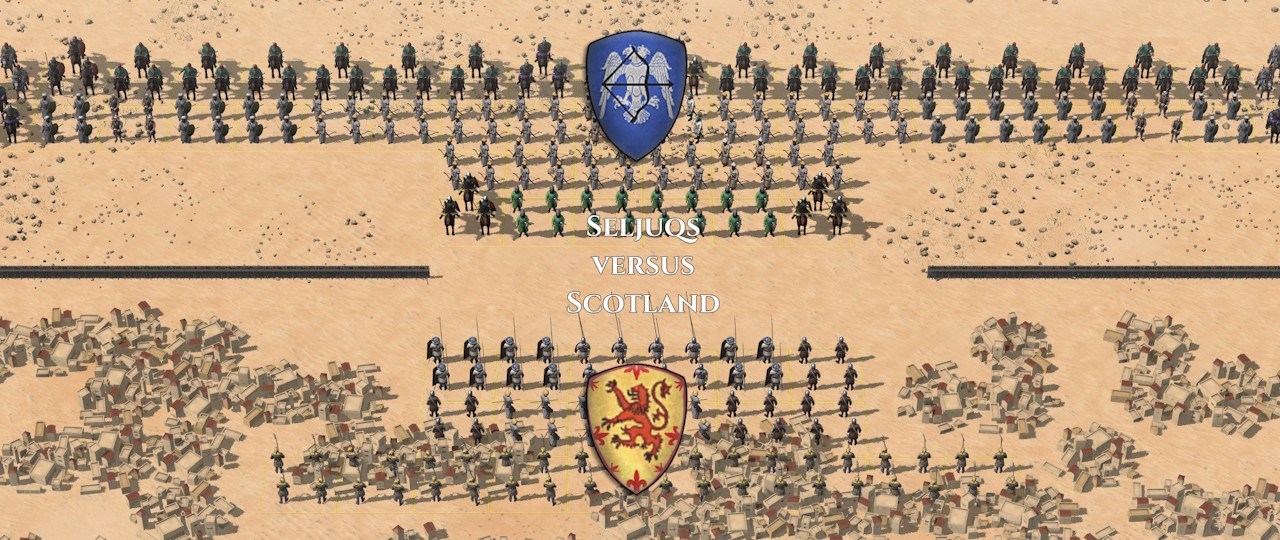It was around turn 360 that my spirit to go on gave out. By that time, I had expanded Scotland to cover, directly or via vassals, the entire British isles. The Kentish kingdom, the sole remnant on England, was holed up in Scandinavia, which I was invading for the third time. Scottish possessions in the Med counted Malta, the Balearics, North Italy, parts of Libya and Egypt. The ride there had been long and fairly fun. Thanks, Field of Glory: Kingdoms.
So, Field of Glory is (was?) a miniature wargaming ruleset. But not everyone has the patience or the money to paint tiny manz for hours on end. So Field of Glory is also a series of video games. But while those games offer us thrilling turn-based battles, they are severely lacking in connecting tissue – their campaigns are just somewhat lackluster series of battles. But as Field of Glory: Empires provided Total War-esque map campaign for the Greco-Roman escapades of Fields of Glory II, Field of Glory: Kingdoms gives Field of Glory II: Medieval the same treatment.

No prize for getting the period right this time. The Grand Campaign takes place between 1054 and 1274, lasting whooping 440 turns. This is a lot; the shorter campaign scenarios – El Cid, Manzikerth, and the Fall of Angevins – clock in between 30 and 50. They limit both the temporal and geographical scope, so that you don’t jump into the deep end by playing some HRE statelet that got eaten in 1055. But even before that, you definitely want to start with the tutorial.
Monty Python quote about kings
So, what do you do in Field of Glory: Kingdoms? Take your nation to the top of the Legacy chart via economic development, diplomacy and conquest. Turns are simultaneous, and units move from region to region in Risk-like manner. So you make all of your decisions, send diplomatic requests, order around units, and click end turn, hoping it will all work.
Of course, before all that excitement, you’ll choose the nation you’ll play. The scenarios present three categories of playable nations: the top dogs (think Byzantium), other interesting nations (like Scotland), and then the rest (all sorts of minor statelets only Wikipedia editors know). The nations themselves can have a handful special rules to set them apart from others – with special snowflakes like HRE getting full bespoke systems – but the differences aren’t as dire as in Total War.
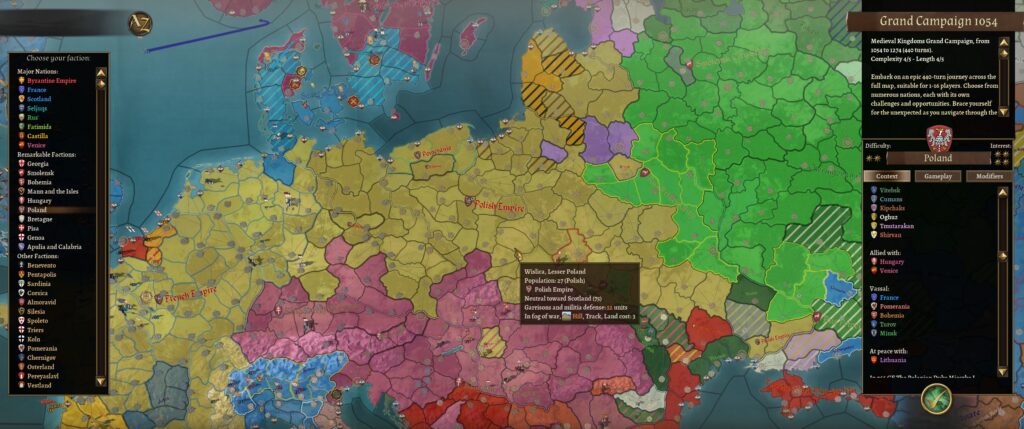
As Field of Glory: Kingdoms is a historical game, nations start roughly within their historical territories. The smallest territory unit is a region – units move between them. And there’s hundreds of regions. Each has their own population, culture, religion, and various other stats. The population is roughly differentiated into peasants and nobles, with the former breaking down into serfs and freemen while the latter is composed of the priestly class and, well, nobles.
This is important since population allocation is much more involved here than even in the most granular Civilization titles.
He who owns the men of production
The peasant population can be freely switched between the economic activities of growing food (and thus growing population), construction (used to build and upkeep structures) and trades (making money – the only basic resource that’s used outside the region). Freemen are more productive and are the only ones that can do trades.
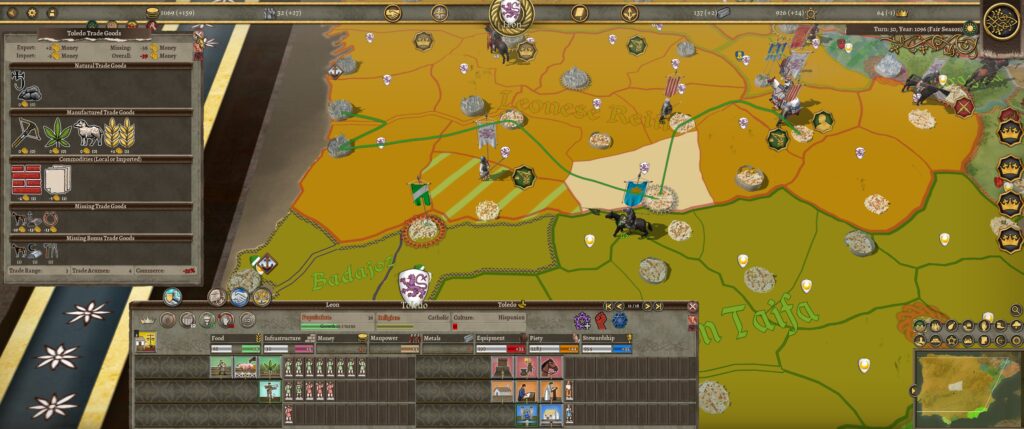
The actual nobles usually handle Stewardship (prevents banditry among other things) generation while the priestly look towards developing Piety (prevents heresy among other things). A balance of the two intangible resources is also necessary for certain good effects. But if needed, nobles can aid with military production while the priestly pops can be switched to construction to symbolize monks pitching in.
Now, the population (read: peasant) micro can become really intense. See, new regional building slots open up when population grows. So you can put all the pop into food production and then, once the building slot opens, switch them to construction to rapidly construct the new improvement. But since some improvements don’t take up a slot, you can prioritize building those (the game gives you five random buildings to choose from, so you can’t just minmax) and, once they’re finished, construct “real” buildings. Afterwards, you can send the peasants back to agriculture and trade.
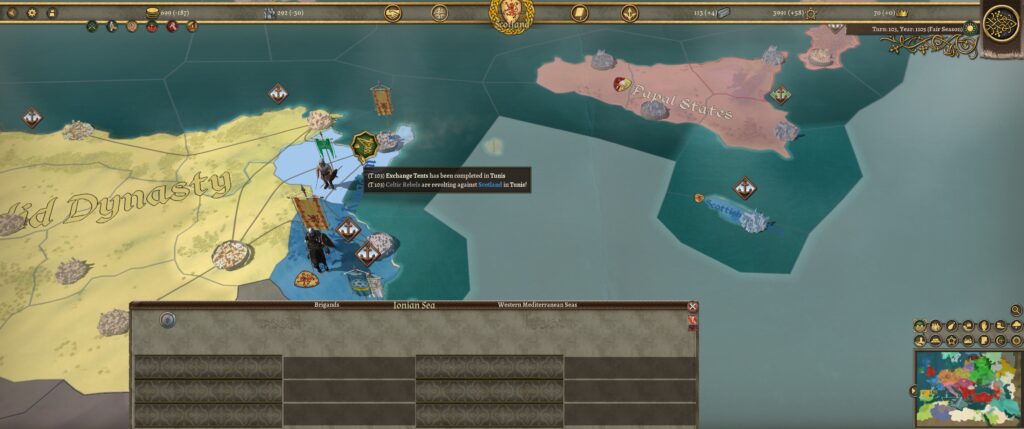
Excess construction isn’t wasted since you can pool it. But if you can blitz construction in a turn by retasking labor, why not use the workers in other spheres instead?
Thankfully, this can be automated, if you trust the AI. I switched most provinces to automation once my empire got too big for me to look constantly after it. It was somewhere around 40 regions – and I should have done it sooner!
Roads roads roads
I can’t overstate how cool Field of Glory: Kingdoms’ (Empires’) “random building selection” is. In Total War, building up provinces is super boring, since you can always run the same build order, money permitting. This applies to most 4X games, from Endless Legend to Stellaris. In Field of Glory: Kingdoms, you can’t optimize that way, so the province development is always a lot more chaotic. If you want to choose from the entire list of projects, you can… by paying a hefty price in Authority. You, uh, don’t want Authority to be low, and either way, it’s impractical to do so for every region in an empire.
Another lovely thing is that buildings don’t cost money, they cost construction. Their upkeep may negatively affect your cashflow, but it doesn’t more often than not. What your structures produce also depends on access to other good, which can be traded auto-
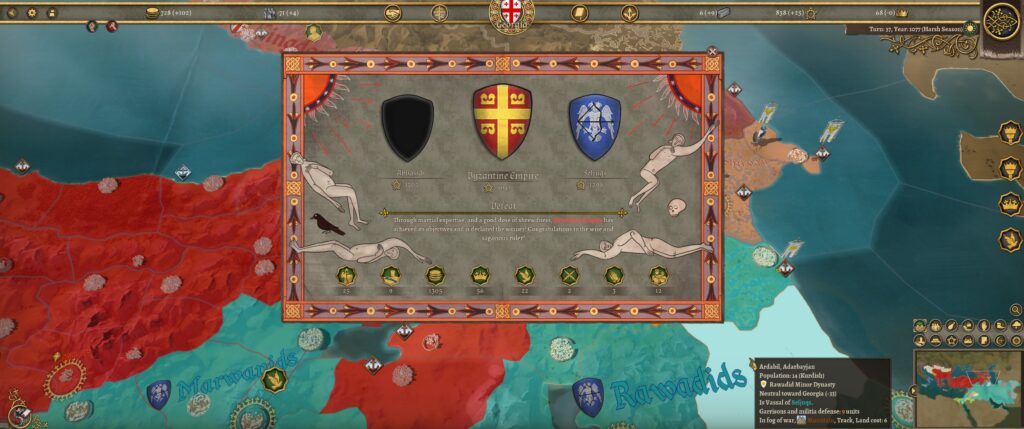
Look, the region development is fairly exciting. You don’t need to minmax it unless you play against some insane AI level and you can fully automate it as mentioned, but it’s there. Having a short bit of text explaining the historical function of the projects in question just adds something special.
Another fun thing is that you don’t need to assign population to the buildings (take that, Civilization). Depending on the combo of buildings, the construction upkeep may pay itself without any peasants (or monks). This is a lot more fun than having to neurotically shuffle around pops, trying to see whether your home planet has enough people to maintain a cinema (looking at you, Stellaris, Galactic Civilizations, etc.).
The enemy will fight to the last drop of peasant blood
But wait, that’s not all! Regions usually grouped into provinces. The benefit of holding the entire province is that you can assign a member of the court to boost its production. Provinces also streamline military recruitment. If you had three loose regions, each one of them would have their own unit availability and weapon production, and then you’d have to gather units from each of them. A province, on the other hand, pools all the military resources and deposits new units in its capital.
Owning a province also allows recruiting its specific unit, which is one of the most exciting things in Field of Glory: Kingdoms. For example, by default, bowmen: the Scots only get levy archers – not the most exciting unit in the world. But if you take some English lands, you can start hiring mercenary crossbowmen!
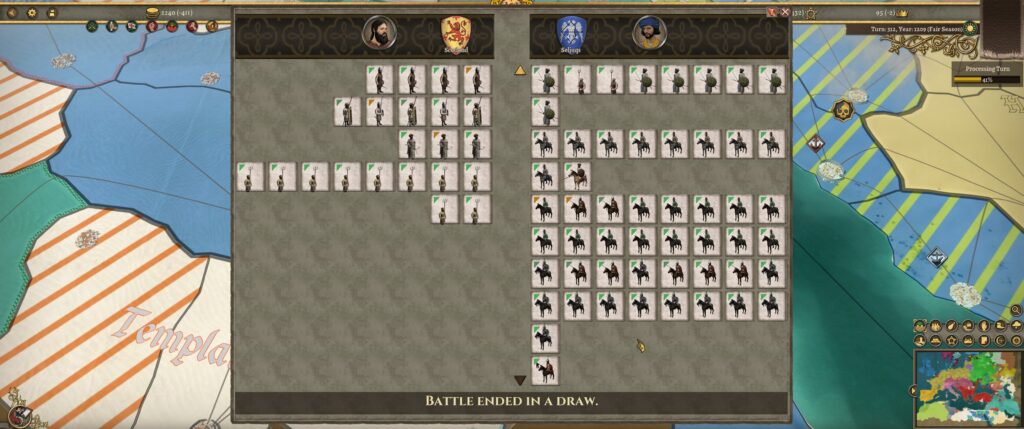
Recruiting units depends on your culture, buildings (sophisticated units need sophisticated infrastructure), and of course, resources: manpower (global), gold (global), equipment (local) and, if you’re unlucky, metal (global).
BUT THERE IS YET MORE. I was mindblown when Crusader Kings II split your army into your house troops and levies you may call up in times of war. This was to simulated that Medieval Europe was, empathetically, not a bunch of absolutist states with established militaries. Similarly, in Field of Glory: Kingdoms, there are three categories unit: standing army units (not the most immersive title), mercenaries and levies.
SAUs are the guys you want to keep around, even if there’s a limit based on your nations grandeur. They don’t cost that much upkeep, they accrue experience fast, and disbanding them doesn’t refund much. Levies are the opposite: great refund, slow experience gain, high maintenance. Mercenaries cost a lot of gold, but not other resources (especially manpower), so they’re very sexy for less populous, but wealthy nations (like Venice). However, disbanding mercs nearly guarantees a bandit infestation in the region you do it.
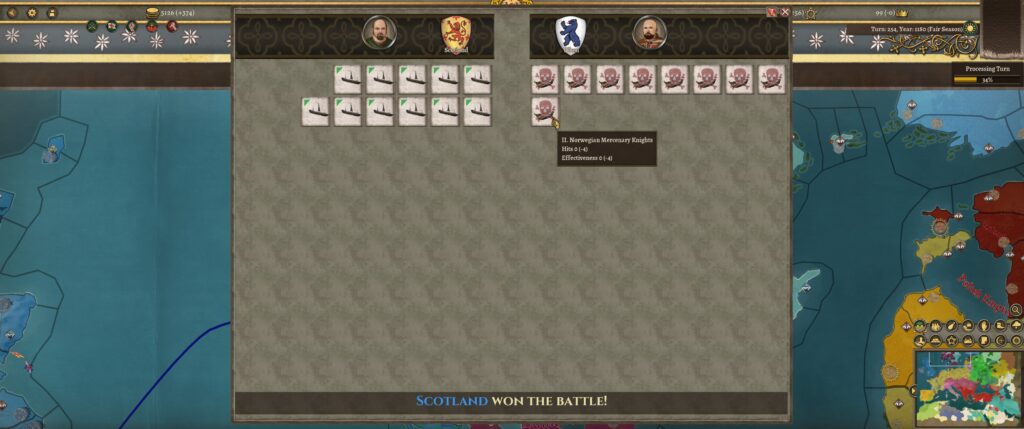
So you can already see that there’s a certain method to declaring a war in Field of Glory: Kingdoms. Once you hear the drums, you draft levies and hire mercenaries, pool them with your SAUs and march off. You then notice that upkeep jumps for units going for adventures beyond your borders.
So while early wars may be limited skirmishes that don’t demand much, later in the game, you will try to establish a war chest (of money, manpower and even metal) before letting loose hounds – and try to finish the conflict before you bleed dry. And once the war is over, you’ll quickly disband levies and mercenaries.
Naturally, running out of any of those military resources is bad in different ways, usually sapping unit power. Oh, and units can also lose effectiveness as well as HP when they fight, so even an unkillable doomstack will crumble if you run a deficit.

By default, battles in Field of Glory: Kingdoms are automated. You can actually spectate them – they’re simplified, with the armies facing off arrayed in two lines, and then units fight 1v1. The model is more involved than just attack stat vs. defense stat, but this is not what you’re here for.
This is, as they say, the good stuff
If you’re fighting a normal land battle (and not a siege or a naval engagement), you can choose to export the battle into Field of Glory II: Medieval. As the turns are simultaneous, this prompts you to close the game – the turn resolution won’t proceed until the battle is resolved. So you fire Medieval up, import the battle with one click, and after you’re done, open Kingdoms again to import the results.
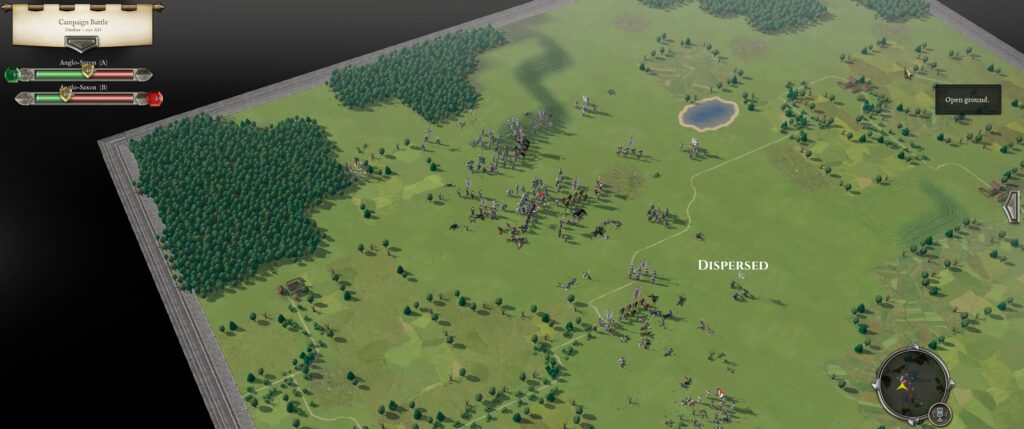
On one hand, it’s a lot of fun. Field of Glory II is probably my most enjoyed game of this type. You can play it by knowing the most bare minimum of rules, and it’s surprisingly exciting to watch two units hack at each other while casualty numbers float heavenwards. The downside comes largely from Field of Glory: Kingdoms: the enemy isn’t overdoing it with army variety.
While the country unit rosters can be quite shallow, the AI absolutely insists on peasant levies. I don’t do that because I want to be a benevolent tyrant ruler, plus, they make for poor soldiers and the Peasant Roundup structure needed to levy them makes the population unhappy. I have to bulldoze them every time I conquer a region.
But I think that the Kingdoms battle model overvalues their contribution to the fight, leading to AI becoming overly fond of rounding up the serfs. Meanwhile, in Medieval, you can easily have your infantry absorb the main blow from the trained troop while your cavalry goes on a flanking quest to see how many peasants they have to kill before the army morale collapses.

So sometimes, manual battle resolution/export isn’t just a pleasure, it’s also a necessity.
The least impressive part of conflicts is sieges. Oh, there are mechanics for determining walls breaches, siege lengths, and so on. But why do that if you can just order a sufficiently large stack to immediately assault enemy fortifications, barely stopping to take the region they’re at? At first, I thought that it would result in many casualties, but no. Apparently, you don’t need to invest a castle if you invest into enough dudes.
Wars – and winning them – are also a huge component of diplomacy. Actually, there are few diplomatic options that aren’t geared explicitly for war . But the most pleasant part of being on the winning side is not just making the enemy to give up gold, disband part of the army, and such, but demanding concessions. Symbolizing hostages, guarantees, and such, concessions sap enemy Legacy.
You fight wars to, in game, humiliate others.
Small men theory
Unfortunately, diplomacy is only next-to-last when it comes to least developed parts of the game. The champions is the characters. They are defined by their stats in running provinces and commanding military forces. They will also have a single random trait that can affect literally. And that’s it. The characters are less characterful than they were way back in the days of Medieval II: Total War, where they would rise (or fall) in stats, gain traits and followers based on what’s happening.
There’s also not much to do with them. Outside of assigning your noble dipshits to run provinces and/or armies (taking both seats tanks their stats a little), the most you can do with your courtiers and relatives is find ways to kill them if their loyalty goes low.
![Field of Glory: Kingdoms screenshot: a menu proclaims that the after the wedding, the king took his bride to a hunting lodge and told everyone not to disturb them [COS THEY'LL BE FUCKING]](https://www.barreldrill.com/wp-content/uploads/2025/04/Field_of_Glory_Kingdoms_review-26-1024x429.jpg)
If you can’t send them to a glorious death in battle, you can only kill them via Decisions. Decisions, like buildings, are generated randomly. The best you can do is either increase or decrease the frequency of their appearance. And they encompass a lot of activities that don’t have their own bespoke systems. Decisions allow you to raise unusual troops, construct special structures, investigate governors for witchcraft or corruption, mess with enemy regions, and so on.
It may sometimes be frustrating to not get the plague-fighting or vassal-creating Decisions turn after turn, but overall, it’s a fun system. And if the Decisions you have are useless, you can always sell them off.
I wouldn’t give a wooden nickel about your legacy! You call them off!
The goal of all the activities I mentioned above is to have the most Legacy points when the scenario times out, though sudden death can be achieved when #1 player maintains a 3x lead (2x with quick victory option) over the #2 for enough turns.
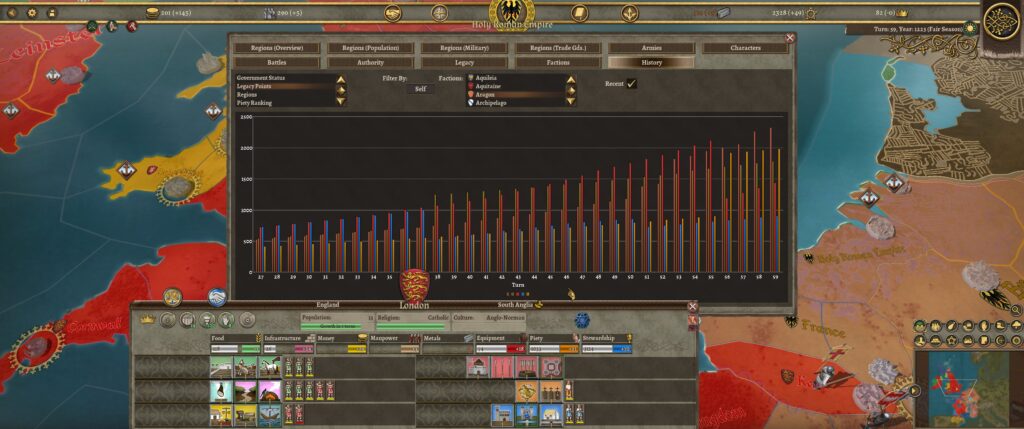
Legacy is gained (and sometimes lost) in a vide variety ways. It depends on the balance of Piety and Stewardship levels in your lands, on some specific buildings, and so on. The track is pretty dynamic and I’ve seen some shocking developments and upsets on it. Almoravids had a fairly solid lead before getting Reconquista’d out of the peninsula, and Poland shot to the top after somehow vassalizing France.
But Legacy isn’t just mere high score. Nations in the top 10 chart by legacy have increased odds of getting development tokens, necessary to advance your nation to the next step of grandeur, to grow from a petty chiefdom to a kingdom to an empire.
So yes, Field of Glory: Kingdoms manages to make the high score have gameplay implications.
I’ve already gone too long talking about the way the game is played. But how does it sound and look? Well, I can overstate how fun the medievalesque art in the loading screens is. It’s a lot more martial than marginalia and depicts what must be real battles – very cool. The rest of the game is serviceable. The campaign map looks OK, I’ve certainly seen worse (Dominions, for example). The interface is also fairly nice, which is a relief whenever you play a grog game.
The biggest downside is with, once again, characters. At least as Scotland, I saw portraits repeated even within the same generation. One may be your brother, another may be some random courtier, both look the same. It is an upsetting turn of events, and it makes your characters hard to care about – only Europa Universalis is more impersonal.
Game good
All in all, Field of Glory: Kingdoms is a great game for anyone who is interested in Field of Glory II: Medieval, but laments its lack of free-form campaigns. If you can be satisfied with complete lack of interpersonal drama that Crusader Kings made us used to, you should buy it the moment you close this window.

